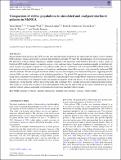Comparison of stellar populations in simulated and real post-starburst galaxies in MaNGA
Abstract
Recent integral field spectroscopic (IFS) surveys have revealed radial gradients in the optical spectral indices of post-starburst galaxies, which can be used to constrain their formation histories. We study the spectral indices of post-processed mock IFS datacubes of binary merger simulations, carefully matched to the properties of the MaNGA IFS survey, with a variety of black hole feedback models, progenitor galaxies, orbits and mass ratios. Based on our simulation sample, we find that only major mergers on prograde-prograde or retrograde-prograde orbits in combination with a mechanical black hole feedback model can form galaxies with weak enough ongoing star formation, and therefore absent Hα emission, to be selected by traditional PSB selection methods. We find strong fluctuations in nebular emission line strengths, even within the PSB phase, suggesting that Hα selected PSBs are only a subsample of the underlying population. The global PSB population can be more robustly identified using stellar continuum-based approaches. The difficulty in reproducing the very young PSBs in simulations potentially indicates that new sub-resolution star formation recipes are required to properly model the process of star formation quenching. In our simulations, we find that the starburst peaks at the same time at all radii, but is stronger and more prolonged in the inner regions. This results in a strong time evolution in the radial gradients of the spectral indices which can be used to estimate the age of the starburst without reliance on detailed star formation histories from spectral synthesis models.
Citation
Zheng , Y , Wild , V , Lahén , N , Johansson , P H , Law , D , Weaver , J R & Jimenez , N 2020 , ' Comparison of stellar populations in simulated and real post-starburst galaxies in MaNGA ' , Monthly Notices of the Royal Astronomical Society , vol. 498 , no. 1 , pp. 1259–1277 . https://doi.org/10.1093/mnras/staa2358
Publication
Monthly Notices of the Royal Astronomical Society
Status
Peer reviewed
ISSN
1365-2966Type
Journal article
Description
YZ acknowledges support of a China Scholarship Council – University of St Andrews Scholarship. VW and NJ acknowledge support from the European Research Council Starting Grant SEDMorph (P.I. V. Wild). NL and PHJ acknowledge support by the European Research Council via ERC Consolidator Grant KETJU (no. 818930).Collections
Items in the St Andrews Research Repository are protected by copyright, with all rights reserved, unless otherwise indicated.
Related items
Showing items related by title, author, creator and subject.
-
SDSS-IV MaNGA: How the stellar populations of passive central galaxies depend on stellar and halo mass
Oyarzún, Grecco A.; Bundy, Kevin; Westfall, Kyle B.; Tinker, Jeremy L.; Belfiore, Francesco; Argudo-Fernández, Maria; Zheng, Zheng; Conroy, Charlie; Masters, Karen L.; Wake, David; Law, David R.; McDermid, Richard M.; Aragón-Salamanca, Alfonso; Parikh, Taniya; Yan, Renbin; Bershady, Matthew; Sánchez, Sebastián F.; Andrews, Brett H.; Fernández-Trincado, José G.; Lane, Richard R.; Bizyaev, D.; Boardman, Nicholas Fraser; Lacerna, Ivan; Brownstein, J. R.; Drory, Niv; Zhang, Kai (2022-07-06) - Journal articleWe analyze spatially resolved and co-added SDSS-IV MaNGA spectra with signal-to-noise ratio ∼100 from 2200 passive central galaxies (z ∼ 0.05) to understand how central galaxy assembly depends on stellar mass (M*) and halo ... -
Secular-and merger-built bulges in barred galaxies
Mendez Abreu, Jairo; Debattista, V. P.; Corsini, E. M.; Aguerri, J. A. L. (2014-12) - Journal articleContext. Historically, galaxy bulges were thought to be single-component objects at the center of galaxies. However, this picture is now questioned since different bulge types with different formation paths, namely classical ... -
Galaxy And Mass Assembly (GAMA) : galaxy close pairs, mergers and the future fate of stellar mass
Robotham, A. S. G.; Driver, S. P.; Davies, L. J. M.; Hopkins, A. M.; Baldry, I. K.; Agius, N. K.; Bauer, A. E.; Bland-Hawthorn, J.; Brough, S.; Brown, M. J. I.; Cluver, M.; De Propris, R.; Drinkwater, M. J.; Holwerda, B. W.; Kelvin, L. S.; Lara-Lopez, M. A.; Liske, J.; Lopez-Sanchez, A. R.; Loveday, J.; Mahajan, S.; McNaught-Roberts, T.; Moffett, A.; Norberg, P.; Obreschkow, D.; Owers, M. S.; Penny, S. J.; Pimbblet, K.; Prescott, M.; Taylor, E. N.; van Kampen, E.; Wilkins, S. M. (2014-11-11) - Journal articleWe use a highly complete subset of the Galaxy And Mass Assembly II (GAMA-II) redshift sample to fully describe the stellar mass dependence of close pairs and mergers between 10(8) and 10(12)M(circle dot). Using the analytic ...

